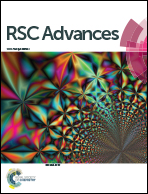Characterization of an exopolysaccharide from probiont Enterobacter faecalis MSI12 and its effect on the disruption of Candida albicans biofilm†
Abstract
Biofilm-forming pathogens are a potential threat to indwelling medical devices and infectious diseases. Management of device-associated Candida infections remains challenging with the existing drug discovery platforms. The available antifungal drugs are effective for the control of free-living pathogens but not effective on biofilm-forming pathogens. Thus an antifungal drug synergized with an antibiofilm agent would be an effective strategy to treat Candida biofilms. Mature C. albicans biofilms are anchored by a complex architecture in terms of distribution of fungal cells stabilized by exocellular polymeric substances. The findings of the present study provide a new insight on the possible development of enterococci probiotics and/or its exopolysaccharide (EPS) as synergistic with existing antifungal drugs to treat biofilm infections. The probiont Enterococcus faecalis MSI12 was picked from 142 seawater isolates screened for EPS production using a congo red plate assay. The probiotic characteristics of the isolate MSI12 were evaluated based on the temperature, pH, acid tolerance, autoaggregation, hydrophobicity and antioxidant activity. The biofilm disruption ability of the lyophilized EPS was determined in a microtitre plate assay using fluconazole as reference drug. Scanning electron microscope and confocal laser scanning microscope images were used for analysis of antibiofilm activity. The cell viability of E. faecalis MSI12 was very high at higher temperature, acidic pH, bile salt and salt concentration when compared to the reference strain Lactobacillus plantarum. Therefore the strain MSI12 might survive in the niche like human gut without prebiotics. The EPS from Enterococcus sp. MSI12 showed significant reduction of the treated Candida biofilm. The antibiofilm potential of EPS was much stronger than the standard antifungal drug fluconazole. This study revealed that biofilm disruption/control using a probiont EPS could deliver a synergistic approach as the probiotic strain can colonize in the host to prevent the formation of Candida biofilms.


 Please wait while we load your content...
Please wait while we load your content...